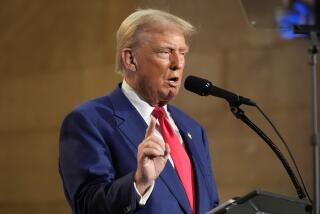Obama seeks massive tax break for business
- Share via
Reporting from Washington — President Obama this week will call for tax incentives that would allow businesses to write off 100% of new capital investment through 2011 — moves that the White House says could save businesses $200 billion over two years.
FOR THE RECORD:
Economic proposals: An article in Tuesday’s Section A about President Obama proposing measures to bolster the economy quoted the president as saying Republicans “talk about me like I’m a dog.” In fact, Obama referred to “powerful interests,” not Republicans, and said they “talk about me like a dog.” —
The far-ranging tax proposal is one of a series of economic measures the White House planned to release this week. The first came Monday when Obama called for a $50-billion boost in spending on the nation’s roads, runways and railroads, his latest effort to respond to the stubbornly sluggish economy in a political climate turning against his party.
The $50-billion spending plan, Obama said, would put construction workers back on the job and rebuild deteriorating infrastructure.
“It’s a plan that says even in the aftermath of the worst recession in our lifetimes, America can still shape our own destiny, we can still move this country forward, we can still leave our children something better … something that lasts,” the president said, in an often rousing campaign-style speech at a union-organized rally in Milwaukee.
Hours after the president spoke, the White House said that Obama would announce the business tax cuts Wednesday. “This unprecedented step would be the largest temporary investment incentive in American history,” the White House said in a statement.
The proposal amounts to an acceleration of business tax cuts over two years, the White House said. Most of the money would be recouped by the U.S. Treasury over time as the economy strengthens, so the total cost to taxpayers over 10 years would be $30 billion, according to the Obama administration.
Several million people and 1.5 million businesses stand to benefit from the proposal, the White House said.
The economic initiatives come as Democratic candidates are launching the final leg of their campaigns for November’s midterm election. In many cases they are facing a harsh assessment from voters frustrated by the pace of economic recovery. Polls show voters are uneasy with the economy, unhappy with the rising deficits and willing to give Republican policies a try.
The infrastructure plan leads the way for economic proposals that the White House hopes will have an effect on the economy and voters’ views of Democrats.
The White House said the $50 billion in initial spending would be used to build or repair 150,000 miles of road, 4,000 miles of railways and 150 miles of airport runways, as well as to support a modernization of the air traffic control system.
The president also planned to call for the creation of an infrastructure bank that would leverage funding for projects that reached a regional or national scale. Over the next six years, the plan would continue funding for high-speed rail, consolidate more than 100 small transportation programs, and prioritize investments in projects that lower greenhouse-gas admissions and reduce oil consumption.
Obama used the appearance to defend his policies, and once went off-script to say Republicans “talk about me like I’m a dog.”
The president accused House Minority Leader John A. Boehner of belittling government jobs and derided the Ohio Republican as the “the man with the plan to be speaker.” Referring to government workers, Obama said, “These are the people who teach our children. These are the people who keep our streets safe. These are the people who put their lives on the line for our own… I don’t know about you, but I think those jobs are worth saving.”
Boehner, meanwhile, quickly sought to label Obama’s plan as more of the same.
“The White House has chosen to double-down on more of the same failed ‘stimulus’ spending,” Boehner said in a statement. “If we’ve learned anything from the past 18 months, it’s that we can’t spend our way to prosperity.”
Senior administration officials Monday declined to predict how many jobs could be created. They said only that the number would be “substantial” and they expected results next year.
The officials also resisted describing the $50-billion proposal as a stimulus measure, instead casting it as part of a long-term infrastructure plan to be put before Congress in the fall. The bill would be “front-loaded” to spend money quickly, with the intention of creating jobs in the short term.
The White House hopes to cover the costs by closing a series of tax breaks for oil and gas companies.
“This is a plan that will be fully paid for. It will not add to the deficit over time; we’re going to work with Congress to see to that,” Obama said.
It is unclear whether Congress will have the appetite for another major spending bill. Congressional Democrats have spent much of this campaign season defending themselves against Republican charges of wasteful and unnecessary spending that ballooned the deficit and delivered few results.
Polls have shown that the stimulus spending package passed last year has not been popular, particularly with independent and fiscally conservative voters.
Rep. Adam Smith (D-Wash.) applauded Obama’s infrastructure proposal, as well as a plan to extend research and development tax credits, but was circumspect in assessing the initiatives’ chances of being approved by Congress.
“In both instances, we’re going to see how they’re paid for and plugged into the economic mix,” Smith said. He also said it was unrealistic to expect either initiative to have a significant short-term effect on the economy or job market.
The $50-billion plan amounts to slightly more than what was allocated to highway, rail and other transportation projects in last year’s $814-billion stimulus package. Critics derided some of those projects as wasteful, and others, including many in the construction industry, complained about delays at the state level in getting projects approved and launched.
Even so, private economists have estimated that the recovery act overall boosted employment by more than 3 million jobs. And analysts say there’s little question that government spending on infrastructure can give a shot in the arm to the economy, generating a hefty amount of jobs for an industry that desperately needs them.
Construction employment is down nearly 2 million from late 2007, accounting for about a quarter of the nation’s job losses over the recession.
Ken Simonson, chief economist at Associated General Contractors, a trade group, said Monday that $50 billion in government transportation spending could yield 1 million jobs or more — half in construction and related manufacturing and services, such as architectural and engineering, and the other half in supporting businesses.
“Investment in infrastructure has been a very effective form of stimulus,” he said of last year’s recovery act. “It’s kept a lot more construction workers on the job than had it not passed.”
Few experts are hopeful about the administration’s chances of making a significant improvement in the short term.
“There’s nothing that can be done to make a material difference before the elections in November,” said Jim Kessler, vice president for policy at Third Way, a moderate Democratic think tank in Washington.
Still, Kessler viewed Obama’s new measures as an important political move. “He has to show he’s focused like a laser beam on the economy and that he has a plan for getting the country moving toward economic growth.”
Peter Nicholas of the Tribune Washington Bureau contributed to this report.
More to Read
Get the L.A. Times Politics newsletter
Deeply reported insights into legislation, politics and policy from Sacramento, Washington and beyond. In your inbox three times per week.
You may occasionally receive promotional content from the Los Angeles Times.












